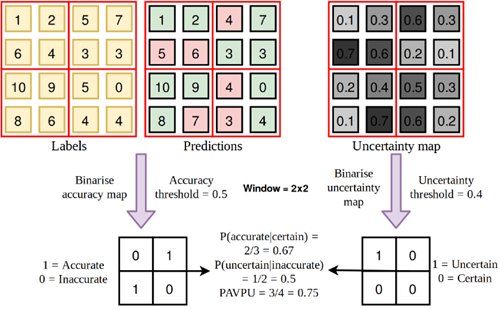This repository contains the implementation of the Patch Accuracy vs. Patch Uncertainty (PAvPU) metric from the paper: https://arxiv.org/pdf/1811.12709.pdf. PAvPU evaluates the performance for Bayesian models in semantic segmentation by comparing the accuracy of the model's predictions to the uncertainty of the predictions. The metric is implemented in NumPy with a foucs on optimizing w.r.t. speed.
- Padding (not in the original paper)
- Alternative metrics such as F1, Recall (not in the original paper) to replace Accuracy.
- Weighting scheme to account for class imbalance (not in the original paper).
- Clone this repository.
- Set working directory to where the repository has been copied to (pavpu/)
- Install
cd pavpu
python setup.py install
Soon to be released on PyPI.
Testing was done on
- the example illustration from the paper and
- on a custom example which represents 2 Monte Carlo samples with 3 classes and 4x4 pixels (2, 3, 4, 4).
Graphical illustration of calculating the PAvPU metric on the example from the paper.
labels = np.array([[1,2,5,7],
[6,4,3,3],
[10,9,5,0],
[8,6,4,4]])
predictions = np.array([[1,2,4,7],
[5,6,3,3],
[10,9,4,0],
[8,7,3,4]])
uncertainty_map = np.array([[0.1, 0.3, 0.6, 0.3],
[0.7, 0.6, 0.2, 0.1],
[0.2, 0.4, 0.5, 0.3],
[0.1,0.7, 0.6, 0.2]])
# pavpu() expects one-hot encoded labels and predictions
def _get_one_hot(targets, nb_classes: int = None):
if nb_classes is None:
nb_classes = len(np.unique(targets))
res = np.eye(nb_classes)[np.array(targets).reshape(-1)]
return res.reshape(list(targets.shape)+[nb_classes])
labels_one_hot = np.transpose(np.expand_dims(_get_one_hot(self.labels),
axis = 0),
axes=(0,3,1,2))
predictions_one_hot = np.transpose(np.expand_dims(_get_one_hot(self.predictions),
axis = 0),
axes=(0,3,1,2))
pavpuscore, a_given_c, u_given_i = pavpu(prediction = predictions,
target = labels,
manual_unc_map = uncertainty_map,
uncertainty_threshold = 0.4,
base_metric_threshold = 0.5,
base_metric = "accuracy")
mc_predictions = np.array([
[
# Monte Carlo sample 1
[
# Class 1
[0.2, 0.5, 0.8, 0.0],
[0.1, 0.7, 0.1, 0.1],
[0.0, 0.6, 0.2, 0.2],
[0.0, 0.0, 0.07, 0.0]
],
# Class 2
[
[0.3, 0.4, 0.2, 0.1],
[0.2, 0.1, 0.1, 0.2],
[0.1, 0.3, 0.3, 0.3],
[0.01, 0.05, 0.93, 0.02]
],
# Class 3
[
[0.5, 0.1, 0.0, 0.9],
[0.7, 0.2, 0.8, 0.7],
[0.9, 0.1, 0.5, 0.5],
[0.99, 0.95, 0.0, 0.98]
]
],
[
# Monte Carlo sample 2
[
# Class 1
[0.3, 0.4, 0.2, 0.1],
[0.2, 0.1, 0.1, 0.2],
[0.1, 0.3, 0.3, 0.3],
[0.15, 0.15, 0.4, 0.3]
],
# Class 2
[
[0.2, 0.5, 0.8, 0.0],
[0.1, 0.7, 0.1, 0.1],
[0.0, 0.6, 0.2, 0.2],
[0.15, 0.35, 0.3, 0.2]
],
# Class 3
[
[0.5, 0.1, 0.0, 0.9],
[0.7, 0.2, 0.8, 0.7],
[0.9, 0.1, 0.5, 0.5],
[0.7, 0.5, 0.3, 0.5]
]
]
], dtype = np.float64)
preds_hard_labels = np.argmax(np.mean(self.sampled_outputs_custom_shape,
axis = 0,
keepdims = True),
axis = 0,
keepdims = True)
target = = np.array([
[# Class 1
[1,1,0,1],
[1,0,0,1],
[1,1,0,1],
[0,0,0,1]
],
[# Class 2
[0,0,1,0],
[0,1,1,0],
[0,0,0,0],
[1,1,0,0]
],
[# Class 3
[0,0,0,0],
[0,0,0,0],
[0,0,1,0],
[0,0,1,0]
]
])
pavpuscore, a_given_c, u_given_i = pavpu(prediction = preds_hard_labels,
target = target,
uncertainty_threshold = 0.3,
base_metric_threshold = 0.1,
base_metric = "accuracy")
- Python >=3.9
- NumPy >= 1.24.2
- scikit-image >= 0.20.0
- scikit-learn >= 1.2.2
Most notably, skimage.util.view_as_windows is a very helpful function used to reshape images to blocks (patches).
